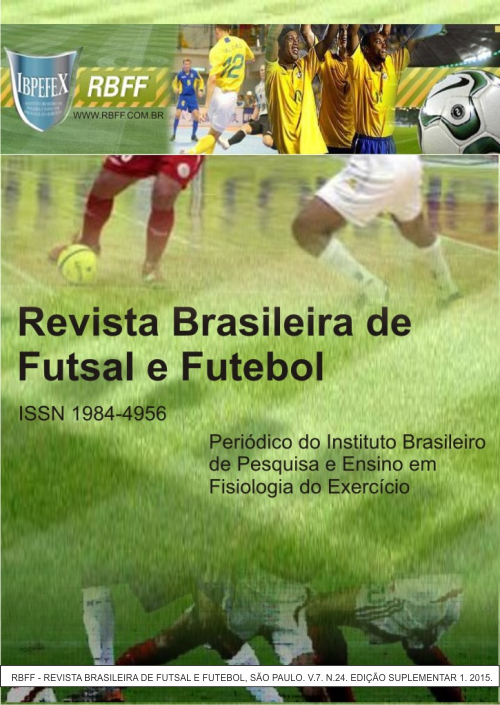Distances covered by professionals football midfielders in matches of top competitions in the world
Abstract
Introduction: Football is an intermittent sport with different physiological capacities involved, where physical trainings are the basis for tactical and technical aspects. In a football match, there are several factors that influence the athlete's displacement, being important to consider their functions in their respective sectors. In this context, the midfield is considered as a sector of big aerobic need, where players have many functions, coursing distances greater than the others. Objective: This study aimed to understand of quantitatively way, characterizing, through the displacements analyzed in recent studies, the distances covered by the professional football midfielders (MC) in matches of top competitions in the world. Materials and Methods: Systematic literature review, using primary and secondary searches in computerized databases. Results: The research resulted in 6 articles that presented results that fit on the objective, recruiting 302 male athletes, using videos, with the average distance covered by players in meters (m) 11000, 10537, 12009, 10894, 11839, 11770. Discussion: The average values found in the recent years demonstrate that they are next to the average values found in the 90s. Another relevant factor, 41% of the analyzed athletes showed superior average to 12000 m, 8% between 11000-11999 m and 51% inferior to 10999 m. Conclusion: Over the past 10 years, the reached average distances in matches, by professional midfielders (MC) were understood between 10537 to 12009 m. Top European athletes showed higher values than the South Americans. However, due to lack of research with South Americans, instigates up that more studies be conducted in this direction.
References
-Andrzejewski, M.; Chmura, J.; Pluta, B.; Kasprzak, A. Analysis of Motor Activities of Professional Soccer Players. Journal of Strength and Conditioning Research. Colorado. Vol. 26. Núm. 6. 2012. p. 1481-1488.
-Bangsbo, J.; Norregaard, L.; Thorsoe, F. Active Profile of Competition Soccer. Canadian Journal of Sports and Physical Sciense. Copenhagen. Vol. 16. Núm. 2. 1991. p.110-116.
-Barros, T. L.; Guerra I. Ciência do Futebol. 1ª ed. São Paulo. Editora Manole Ltda. 2007. p. 1-20.
-Barros, R. M. L.; Misuta, M. S.; Menezes, R. P.; Figueroa, P. J.; Moura, F. A.; Cunha, S. A.; Anido, R.; Leite, N. J. Analysis of the Distances covered by first division Brazilian soccer players obtained with an automatic tracking method. Journal of Sports Science and Medicine. Bursa. Vol. 6. 2007. p. 233-242.
-Braz, T. V.; Spigolon, L. M. P.; Vieira,N. A.; Borin, J. P. Modelo Competitivo da Distância Percorrida por futebolistas na UEFA Euro 2008. Revista Brasileira de Ciências do Esporte. Vol. 31. Núm. 3. 2010. p. 177-191.
-Chamari, K.; Hachana, Y.; Ahmed, Y. B.; Galy, O.; Sghaier, F.; Chatard, J. C. Field and Laboratory Testind in Young Elite Soccer. British Journal of Sports Medicine. London. Vol. 38. 2004. p. 191-196.
-Di Salvo,V.; Baron, R.; Tschan, H.; Calderon Montero, F. J.; Bachl, N.; Pigozzi, F. Performance Characteristics According toPlaying Position in Elite Soccer. International Journal of Sports Medicine. Stuttgart. Vol. 28. 2007. p. 222-227.
-Dupont, G.; Nedelec, M.; McCall, A.; McCormacK, D.; Berthoin, S.; Wisloff, U. Effect of 2 Soccer Matches in a Week on Physical Performanceand Injury Rate. The American Journal of Sports Medicine. Chicago. Vol. 38. 2010. p. 1752-1758.
-Drubscky, R. O Universo Tático do Futebol: Escola Brasileira. Belo Horizonte. Editora Health. 2007. p. 19-272.
-Ekblom, B. Applied Physiology of Soccer. International Journal of Sports Medicine. Stockholm. Vol. 3. 1986. p. 50-60.
-Kokubun, E.; Molina, R.; Ananias, G. E. O. Análise de deslocamentos em Partidas de Basquetebol e de Futebol de Campo: Estudo exploratório através da análise de séries temporais. Motriz. Vol. 2. Núm. 1. 1996. p. 20-25.
-Mohr, M.; Krustrup, P.; Bangsbo, J. Match Performance of high-standard soccer players with special reference to development of fatigue. Journal of Sports Sciences. Londres. Vol. 21. 2003. p. 519-528.
-Rienzi, E.; Drust, B.; Reilly, T.; Carter, J. E. L.; Martin, A. Investigation of anthropometric and work-rate profiles of elite South American international soccer players.The Journal of Sports Medicine and Physical Fitness. Torino. Vol. 40. 2000. p. 162-169.
-Seluianov, V. N.; Sarsania, S. K.; Sarsania, K. S. Futebol Aspectos Fisiológicos e Metodológicos. Curitiba. Juruá Editora. 2011. p. 99-105.
-Souza, J.; Zucas, S. Alterações da Resistência Aeróbia em Jovens Futebolistas em um Período de 15 Semanas de Treinamento. Revista da Educação Física/ UEM. Maringá. Vol. 14. Núm. 1. 2003. p. 31-36.
Authors who publish in this journal agree to the following terms:
- Authors retain the copyright and grant the journal the right of first publication, with work simultaneously licensed under the Creative Commons Attribution License BY-NC which allows the sharing of the work with acknowledgment of the authorship of the work and initial publication in this journal.
- Authors are authorized to enter into additional contracts separately for non-exclusive distribution of the version of the work published in this journal (eg, publishing in institutional repository or book chapter), with acknowledgment of authorship and initial publication in this journal.
- Authors are allowed and encouraged to post and distribute their work online (eg, in institutional repositories or on their personal page) at any point before or during the editorial process, as this can bring about productive change as well as increase impact and impact. citation of published work (See The Effect of Free Access).





